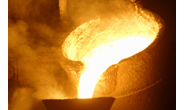International Steel Mills

Tampa Steel: Garcia lays out Algoma Steel's path forward
Written by Ethan Bernard
January 30, 2024
Algoma Steel is currently navigating a challenge as it deals with an unplanned outage at its blast furnace, but the company’s CEO is still bullish on its future as an EAF steelmaker.
Michael Garcia, CEO of the Sault Ste. Marie, Canada-based company, sat down with SMU Managing Editor Michael Cowden for a Fireside Chat at the Tampa Steel Conference 2024 on Monday.
Unplanned outage update
A structure supporting utilities piping at the plant collapsed on Saturday, Jan. 20. The incident disrupted coke production, but Algoma’s three coke batteries are back in limited operation as Algoma implements a repair plan, Garcia said.
“It will be several weeks before all batteries are back up fully,” he noted.
During the incident, the “blast furnace was evacuated and we had issues bringing the blast furnace back online,” he added.
On Tuesday, Jan. 23, he had announced that the BF would be closed for 10-14 days, and that timeline still holds. The plate and strip mill are running normally at the plant, he added.
The company is undertaking a forensic analysis of what occurred, “and we are recovering as fast as we can,” Garcia said.
EAF transition timeline
Algoma announced in 2021 that it was making the transition from an integrated to an EAF steel producer. Garcia described the project as “on time and on budget.”
He said the budget last year was announced at CAD$825-875 million for two new EAFs. Garcia noted that 86% of that has already been contracted out and that the remaining 14% will continue to track within that budget.
“We are comfortable that we will complete construction by the end of this year and begin commissioning activities. 2025 will be a year of startup for the EAFs,” Garcia said.
“By the end of 2025 we will be able to begin to sunset our coke batteries and our blast furnace,” he added.
However, he said scrap supply and other economic factors could determine when the BF would be shut down.
By the end of decade, as more electrical energy comes online, Garcia said Algoma can go from the current capacity of 2.4 million short tons (st) of finished steel to 3.1. million st.
By switching to EAFs, Algoma will be able to make more steel “with significantly less headcount.”
Though this means there will be a reduction in union jobs, Garcia said the company will be in a much stronger financial position “that could lead to growth opportunities.”
Scrap sourcing
The move to EAF steelmaking will necessitate more prime scrap. Garcia said that when the deal was originally announced in November 2021, it simultaneously announced a joint venture with Canadian scrap company Triple M Metal.
The JV will be a procurer and source of scrap metal for Algoma Steel. “That venture has been operationalized,” Garcia said, noting that they’ve done research on the scrap market in Ontario and the Great Lakes region.
Possible BF restart
Depending on scrap availability, Garcia mentioned that for the first year or two, the company could use BF #7 as a source of hot iron to augment whatever scrap they have.
“We also have BF #6, which was mothballed in 2008, two months after it was completely relined,” Garcia noted.
He said it would take some capital costs to get that BF up and running, but nothing compared to the capital costs for a direct-reduced iron facility.
“If scrap were tight or if it made economic sense to start up BF #6, there’s nothing keeping us from doing that,” Garcia said, noting that this could be during the 2028-30 time period, depending on the economics of EAF steelmaking at that time.
Outlook
When asked if Algoma would like to own and operate steel service centers, Garcia was clear and to the point: “No,” he said, as the audience chuckled.
For further growth, Algoma is committed to investing in Sault Ste. Marie, but Garcia said the company is open to the idea of expanding to other sites as well by the end of the decade.
Finally, when asked about his leadership style, honed after a long career in the US military, Garcia said, “Assemble the best team you can and get them clear on what’s important. And then do your best to get out of the way and help them be successful.”
He was particularly satisfied with his team at Algoma.
“There are lots of passionate, engaged leaders in the steel industry, and that’s magnified at Algoma Steel,” he said.

Ethan Bernard
Read more from Ethan BernardLatest in International Steel Mills

Global steel mill output steady through May
Global raw steel production rose 2% from April to May, slightly above average production levels seen in recent months, according to data recently released by the World Steel Association (worldsteel).

Trump says US government to control 51% share in USS
President Trump says the US government will hold a 51% stake in U.S. Steel after the Nippon deal.

USS, Nippon Steel quiet as litigation deadline approaches
There has been little word from U.S. Steel, Nippon Steel, or the White House since President Trump endorsed the companies’ “partnership” on social media and celebrated it at the May 30 rally outside Pittsburgh.

Ternium’s Vedoya named AIST’s Steelmaker of the Year
Maximo Vedoya was awarded in recognition of Ternium’s expansion project in Pesquería, Mexico, and Ternium’s efforts to decarbonize steelmaking.

CRU: Baosteel hints at output cuts in China
Baosteel exec comments on market rumors of 50 million tons of output being cut this year, less than 0.5% of the 1 billion tons-plus China has produced annually in recent years.
